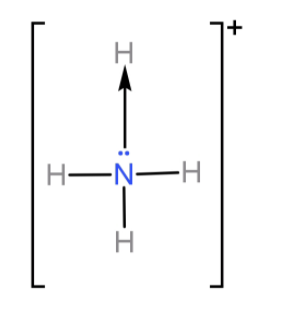
The maximum covalency of nitrogen is:
(A) 3
(B) 4
(C) 5
(D) 6
Answer
218.4k+ views
Hint: To find the covalency of N first see the number of valence electrons it has and then the total number of possible bonds it can form with these electrons while keeping in mind the number of electrons it can accommodate in its valence shell.
Complete step by step answer:
-First let us see what covalency is. Covalency is defined as the total number of electron pairs that an atom can share with other atoms. It can also be defined as the total number of orbitals available in the valence shell (outermost shell), whether they are empty or completely filled. We usually count the number of covalent bonds formed.
If an atom can share only 1 electron its covalency will be 1 and if an atom can share only 2 electrons its covalency will be 2.
-The maximum covalency of any element is found by counting the number of covalent and coordinate bonds that can be formed by it.
-Now about nitrogen, its atomic number is 7 and so its electronic configuration is written as: $1{s^2}2{s^2}2{p^3}$. From the electronic configuration of N atom we can see that it has two 2s electrons and three 2p valence electrons.
N atom shares its three 2p electrons with 3 H atoms to form ammonia ($N{H_3}$) molecule and completes its octet. So it cannot form any more covalent bonds. But even after sharing these 3 electrons N atom is left with its lone pair from the 2s orbital. Now ammonia donates this lone pair of electrons to form one coordinate covalent bond with a proton and forms ammonium ion ($N{H_4}^ + $).

So, we have seen that N can form 4 bonds in total (3 covalent bonds and 1 co-ordinate bond). And so the covalency of N will be 4.
So, the correct option will be: (B) 4.
Note:
Even though N atom has 5 electrons in its valence shell, its covalency cannot be 5. It will be 4 only because N can accommodate a maximum of 8 electrons in its outermost shell. When its three 2p electrons bond with H the octet becomes completely filled. So, neither can any more covalent bonds be formed nor can the lone pair be broken and thus one coordinate bond can be formed. Hence, it cannot have covalency more than 4.
Complete step by step answer:
-First let us see what covalency is. Covalency is defined as the total number of electron pairs that an atom can share with other atoms. It can also be defined as the total number of orbitals available in the valence shell (outermost shell), whether they are empty or completely filled. We usually count the number of covalent bonds formed.
If an atom can share only 1 electron its covalency will be 1 and if an atom can share only 2 electrons its covalency will be 2.
-The maximum covalency of any element is found by counting the number of covalent and coordinate bonds that can be formed by it.
-Now about nitrogen, its atomic number is 7 and so its electronic configuration is written as: $1{s^2}2{s^2}2{p^3}$. From the electronic configuration of N atom we can see that it has two 2s electrons and three 2p valence electrons.
N atom shares its three 2p electrons with 3 H atoms to form ammonia ($N{H_3}$) molecule and completes its octet. So it cannot form any more covalent bonds. But even after sharing these 3 electrons N atom is left with its lone pair from the 2s orbital. Now ammonia donates this lone pair of electrons to form one coordinate covalent bond with a proton and forms ammonium ion ($N{H_4}^ + $).

So, we have seen that N can form 4 bonds in total (3 covalent bonds and 1 co-ordinate bond). And so the covalency of N will be 4.
So, the correct option will be: (B) 4.
Note:
Even though N atom has 5 electrons in its valence shell, its covalency cannot be 5. It will be 4 only because N can accommodate a maximum of 8 electrons in its outermost shell. When its three 2p electrons bond with H the octet becomes completely filled. So, neither can any more covalent bonds be formed nor can the lone pair be broken and thus one coordinate bond can be formed. Hence, it cannot have covalency more than 4.
Recently Updated Pages
The hybridization and shape of NH2 ion are a sp2 and class 11 chemistry JEE_Main

What is the pH of 001 M solution of HCl a 1 b 10 c class 11 chemistry JEE_Main

Aromatization of nhexane gives A Benzene B Toluene class 11 chemistry JEE_Main

Show how you will synthesise i 1Phenylethanol from class 11 chemistry JEE_Main

The enolic form of acetone contains a 10sigma bonds class 11 chemistry JEE_Main

Which of the following Compounds does not exhibit tautomerism class 11 chemistry JEE_Main

Trending doubts
JEE Main 2026: Application Form Open, Exam Dates, Syllabus, Eligibility & Question Papers

Derivation of Equation of Trajectory Explained for Students

Hybridisation in Chemistry – Concept, Types & Applications

Understanding the Angle of Deviation in a Prism

Understanding Collisions: Types and Examples for Students

Understanding Atomic Structure for Beginners

Other Pages
NCERT Solutions For Class 11 Chemistry Chapter 7 Redox Reaction

JEE Advanced Marks vs Ranks 2025: Understanding Category-wise Qualifying Marks and Previous Year Cut-offs

Thermodynamics Class 11 Chemistry Chapter 5 CBSE Notes - 2025-26

NCERT Solutions ForClass 11 Chemistry Chapter Chapter 5 Thermodynamics

Equilibrium Class 11 Chemistry Chapter 6 CBSE Notes - 2025-26

How to Convert a Galvanometer into an Ammeter or Voltmeter




